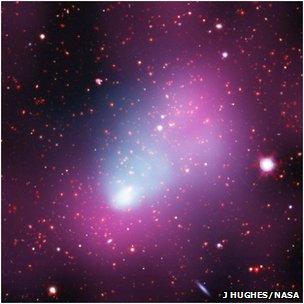'El Gordo' is largest distant galaxy cluster ever seen
- Published

The two merging clusters of El Gordo can be seen separated by a bright field of X-ray light
The largest distant galaxy cluster has been spotted by astronomers using a telescope in Chile.
Galaxy clusters are the largest stable structures in our Universe.
Seven billion light years away and with two million billion times the mass of our Sun, the cluster was nicknamed "El Gordo" - "the Fat One" in Spanish.
Astronomers reporting at the said El Gordo was currently undergoing a merger and growing even larger.
Alongside other clusters highlighted at the meeting, astronomers hope to better understand how they form, grow and collide with one another.
Galaxy clusters yield many cosmic superlatives; mergers such as the one that El Gordo appears to be undergoing are the most energetic events in the Universe, as vast amounts of matter - and the mysterious dark matter - crash into each other at breakneck speeds.
The growth of clusters and their mergers are driven by gravity; normal matter we see along with the dark matter imaged on a grand scale in Monday's announcement act to draw things together.
Meanwhile, the even more mysterious dark energy works to drive the expansion of the Universe - to draw things apart.
Mapping out the process of cluster growth will be critical to understand the interplay between these dark forces.
Background check
The cluster was discovered by the Atacama Cosmology Telescope high in the mountains of Chile.
Clusters like El Gordo release energetic particles that have an effect on the cosmic microwave background, the extremely faint glow left over from the Big Bang that permeates the Universe.
"El Gordo is at a distance that corresponds to a distance of about seven billion light years - we're looking at it at a time that the Universe was only half as old as it is now, when structure was forming at a different rate," explained Jack Hughes of Rutgers University in New Jersey, US.
"By looking at and understanding the properties of El Gordo, we're able to understand the time evolution of the structure formation of the Universe," Prof Hughes told ┤¾¤¾┤½├¢ News.
Twice as big as its contemporaries at similar distances, El Gordo represents a galaxy cluster in the middle of a lifetime.
Two rather smaller galaxy clusters were also unveiled that will help lay out this timeline.
A team including Michele Trenti of the University of Colorado used the Hubble telescope to pinpoint a handful of bright galaxies making up the most distant known "protocluster".
The light we see from it now was given off nearly 13 billion years ago, when the Universe was only about 650 million years old, and the team estimates the protocluster itself was just 300 million years old.
"This discovery is remarkable because we are witnessing the infancy of a future galaxy cluster," he told the meeting.
At the other end of the cluster evolution spectrum, William Dawson of the University of California Davis and his colleagues used the Hubble and Chandra space telescopes to spot a cluster in the latest stages of colliding that has ever been seen.
The sparse, widely separated galaxies from two clusters have passed through each other and carried on travelling, but much of the loose, thin gas making up the clusters has remained in the middle of the crash scene.
Mr Dawson said that these snapshots in the lifetimes of the Universe's largest structures were a gateway into learning much more.
"Every great advance in our understanding of the physical universe is a direct result of understanding how things change with time," he told the meeting.
That in turn should shed more light on the relative proportions of dark energy and dark matter, as well as help shore up theoretical models of just how big El Gordo will get.
"El Gordo is going to continue to grow," Prof Hughes said. "We could extrapolate what its mass will be; unfortunately the models are uncertain, but it could become the most massive cluster known about, even when we count the nearby Universe."
- Published9 January 2012
- Published13 January 2011